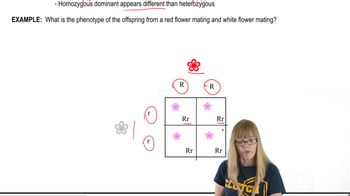Table of contents
- 1. Introduction to Genetics51m
- 2. Mendel's Laws of Inheritance3h 37m
- 3. Extensions to Mendelian Inheritance2h 41m
- 4. Genetic Mapping and Linkage2h 28m
- 5. Genetics of Bacteria and Viruses1h 21m
- 6. Chromosomal Variation1h 48m
- 7. DNA and Chromosome Structure56m
- 8. DNA Replication1h 10m
- 9. Mitosis and Meiosis1h 34m
- 10. Transcription1h 0m
- 11. Translation58m
- 12. Gene Regulation in Prokaryotes1h 19m
- 13. Gene Regulation in Eukaryotes44m
- 14. Genetic Control of Development44m
- 15. Genomes and Genomics1h 50m
- 16. Transposable Elements47m
- 17. Mutation, Repair, and Recombination1h 6m
- 18. Molecular Genetic Tools19m
- 19. Cancer Genetics29m
- 20. Quantitative Genetics1h 26m
- 21. Population Genetics50m
- 22. Evolutionary Genetics29m
3. Extensions to Mendelian Inheritance
Variations of Dominance
Problem 14b
Textbook Question
Textbook QuestionHorses can be cremello (a light cream color), chestnut (a brownish color), or palomino (a golden color with white in the horse's tail and mane). Of these phenotypes, only palominos never breed true. Predict the F₁ and F₂ results of many initial matings between cremello and chestnut horses.
 Verified Solution
Verified SolutionThis video solution was recommended by our tutors as helpful for the problem above
Video duration:
1mPlay a video:
Was this helpful?
Key Concepts
Here are the essential concepts you must grasp in order to answer the question correctly.
Incomplete Dominance
Incomplete dominance occurs when the phenotype of heterozygotes is intermediate between the phenotypes of the two homozygotes. In the case of horse coat colors, a cremello (homozygous for a cream allele) crossed with a chestnut (homozygous for a brown allele) may produce offspring that exhibit a blend of these traits, leading to a distinct phenotype in the F₁ generation.
Recommended video:
Guided course

Variations on Dominance
Punnett Square
A Punnett square is a diagram used to predict the genotypes of offspring from a genetic cross. By setting up a Punnett square for the cremello and chestnut horses, one can visualize the potential combinations of alleles in the F₁ generation, helping to determine the expected ratios of phenotypes and genotypes in the offspring.
Recommended video:
Guided course

Chi Square Analysis
F₁ and F₂ Generations
The F₁ generation refers to the first filial generation of offspring resulting from a cross between two parental (P) genotypes. The F₂ generation is produced by interbreeding the F₁ individuals. Analyzing the F₁ and F₂ generations allows for understanding inheritance patterns, including the ratios of different phenotypes and the potential for traits to segregate in subsequent generations.
Recommended video:
Guided course

F Factor and Hfr

 4:37m
4:37mWatch next
Master Variations on Dominance with a bite sized video explanation from Kylia Goodner
Start learningRelated Videos
Related Practice

